Tales of the Itinerant Sailor
Cruising 2011
The Little Ship that Couldn't
By
Part I
A brief
review: As is my custom, after
my work season was over, I spent some time on maintenance and hurricane
preparation for the HB Rejoyce in
Key West, FL.
Then it was time to return to what I enjoy most:
Sailing. No sooner had I
booked a flight to the Dominican Republic when I learned of the death of a
very dear friend and gracious lady, Barbara Guilfoil.
A few days later I received information that a Memorial Service was
scheduled for Sunday May 15, in Olympia, Washington, 3,700 miles away.
In the opposite direction.
Attend? Out of the
question.[1]
Then, I
begin to put things in a realistic perspective.
Why not go? I have the
money. My sailing schedule is
not carved in stone. I have the
time. Besides, I have family and
friends nearby, whom I have not seen for a while.
I get on the phone with American Airlines.
They are willing to work with me as this is a benevolence flight, and
the extra cost is very minimal.
I go.
And I am very glad I did.
------------------------------
And so it
is. After a red eye flight from
Seattle, I arrive in the Dominican Republic on Friday May 20.
I spend the next few days with Carmen Rosa, her family, her extended
family and friends. On
Tuesday April 24 Carmen Rosa takes me to the North Coast, to Luperon, the
home base for the s/v Sirius II
for the last two years.
As you may
have guessed from the title, I don’t do much sailing in this episode of the
2011 season. So, I will be
sharing some of my land/cultural observations and experiences within the
cruising community, a culture in and of itself.
We arrive
at Puerto Blanco Marina about 7:00 p.m., hoping to get a dinghy ride out to
the Sirius II.
No one about. We go to
Wendy’s in the town of Luperon.
There we find several cruisers watching the Tuesday Night Movie, including
Lynne Bourne (Suits Us), who
graciously offers to take us out to the
Sirius II—after the movie.
Fair enough. Gives us
time to enjoy a cervesa—Bohemia
grande. Ice cold, as advertised
by Wendy’s Bob.
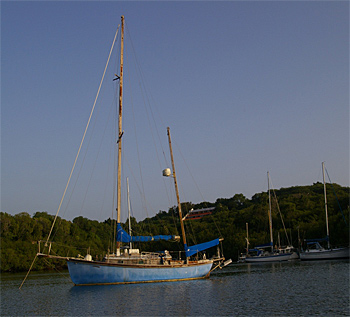 |
| Journey, with the aft mast heeling starboard |
Oops,
while flushing out the head I break the pump handle for the toilet.
This was an omen for things to come, but I didn’t know it.
I was able to make a temporary repair but still need a new part,
which I order over the internet.
Interestingly, when it did come, I found the temporary repair still holding
fast and am now keeping the new part in reserve.
Some
changes in Luperon since my last visit.
Mac’s blue ketch, Journey,
has been towed out of the mangroves and relocated on a buoy.
But it might be too late.
The boat is slowly falling apart.
Mac is a legendary figure around Bahia Luperon, already a familiar
face when I was here the first time in 2001.
He was nearly a part of the fixtures at Puerto Blanco, usually the
first person you saw when walking into the restaurant.
But his health has been failing the
last several years, coupled with foot and leg problems.
Finally, a sister took him back to the States for some supervised
care.
Incidentally, running your boat as close as possible to the mangroves, tying
off the bow there, then placing two anchors astern is the recommended way to
secure a boat for hurricanes.
There are several boats like that right now, whose owners have returned to
their home base for the duration of the hurricane season.
The Yacht
Club is now reopened under new management, but is patronized mainly by
Dominicans. Shaggy’s is now JR’s
Restaurant and Sean (Shaggy) now works for the new marina, Tropical Marine.
This new marina actually has a haul-out service, the only one in
Luperon. The streets are still torn
up, the result of installing new sewer and run off drains begun nearly two
years ago.
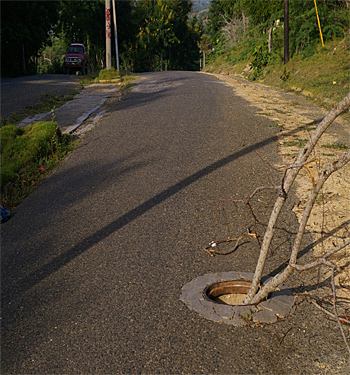 |
| Tree limbs marking a manhole where the cover has been stolen |
JR’s, with
the help of Wendy’s, has put together a fund raising drive to rebuild the
dinghy dock at the government pier, for at least the third time since I have
been coming here. This was after
Gina from Mello Moon, slips and
breaks her leg in two places.
Before I
leave to return to Florida I am able to use this new dinghy dock, but it was
not build with monies donated by the cruisers.
At the last moment, the Dominican government sent a crew from Santo
Domingo to build a new dinghy dock.
Why now? Who knows for
sure. Perhaps because next year
is an election year in the Dominican Republic.
Maybe the local Luperon government petitioned for help as they felt
guilty about not building a new dock themselves.
The marina collects $20 a month from each cruising boat at anchor in
the bahia. This money is
supposed to be used for maintenance such as this.
Where does this money go?
We will never know for sure, but I suspect it does not go into the public
coffers.
Puerto
Blanco Marina traditionally has provided many services for the cruising
community. It is
convenient to buy drinking water and ice here, although these are available
in the town as well. Every Sunday morning they allow cruisers and vendors to
use their facilities for a Swap Meet. Other
special events are held from time to time.
Poker tournaments and, yes, even pinochle matches have been
scheduled. Trivial Pursuit used to be scheduled for every Thursday night;
now it is every other Wednesday at JR’s.
Also, cruisers typically have been able to get water to use for
cooking and showers here; now it is available only sporadically.
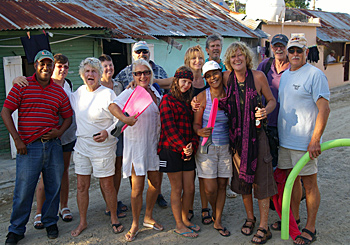 |
| Cruisers and Dominican driver returning from a day at the beach |
I share
all of this with you as these are typical of the services/activities found
anywhere there are a large number of cruisers in one area.
Plus a VHS radio net daily or weekly for the cruising community to
share information, news and safety concerns.
Otherwise,
the number of cruisers at anchor in Bahia Luperon is down and it is a very
slow tourist season for Luperon, adding to the woes of the economy.[2]
The omen
continues. A day or two after
the head handle problem (thank goodness, we didn’t have to use a bucket),
when I start up the diesel engine for the first time to charge the
batteries, I immediately notice that there is no water coming out with the
exhaust. Marine engines are
typically fresh water cooled, but the fresh water is cooled with sea
water—as opposed to air through a radiator as in the case of automobiles.
There are four possible causes for this, and of course it is the last
one that I check: The sea water
pump is frozen solid. “Frozen”
might not be an appropriate word to use in a tropical environment, but you
get the point.
Yanmar,
the manufacturer, no longer makes repair kits for this pump, and it is not
possible to buy a new pump from them.
I have to go through a dealer.
From my dealer in Key West, it will cost nearly $400 with freight and
custom’s charges. But I hear
about a Yanmar dealer in Santo Domingo who might be able to help or repair
this pump. So, to Santo Domingo
we go, to B & R Marine in the commercial district of Santo Domingo, where
the mechanic/technician Umberto assures me that this is repairable, and he
has the parts in stock! In the
end I also buy a new pump that he finds on the internet and the total cost
is less than what I found through normal channels.
I am well pleased.
Omen #3.
The GPS that I installed last year in the cockpit is not working.
The power cable is corroded.
The pinhole electrical connection is so small that I can’t clean it.
Rafael, one of the local Dominicans who provide services to cruisers,
refers me to a friend in Santiago (nearly two hours away) who might be able
to help. And he does.
He cleans and solders a new connection and the GPS is working again!
Now, with
all mechanical problems tended to, head sail unfurled (i.e., taken out of
the cabin where I store it and affixed to the furling system), the
Sirius II is ready for a sea
trial. This we do on June 8.
First, I really enjoy being able to guide the boat through the
channel without leaving the cockpit, relying on the GPS in the cockpit.
Much easier, and safer, than trying to peer down into the cabin to
see the chart on the laptop.
Initially,
the auto pilot is erratic, but after a few adjustments it seems to behave
better. (Later I learn from
Carmen, who was at the wheel nearly the entire trial, the auto pilot
continued to misbehave: She was
just better able to make manual corrections without me realizing it).
I spend the next several minutes on
the fore deck adjusting lines, preparing the whisker pole, etc.
When I do leave on this journey, I will be going west, with the wind,
sailing a broad reach. I will
need the aide of the whisker pole to keep the head sail in place.
Omen #4. On the way back to Luperon,
under power into the wind, the engine overheats. Opening the hatch to allow
more air into the engine compartment cools the engine, but the cause puzzles
me. There appears to be sufficient sea water coming out of the exhaust.
Surely, I properly adjusted the belts when I installed the new water pump.
Yes, I did. The problem is at the Y connection at the end of the exhaust manifold where the sea water mixes with the exhaust. A build up of carbon and corrosion. So, with a hammer and chisel, and sulfuric acid, I clean out the corrosion. Idling the engine for long periods of time, such as charging the house batteries, contributes to this build up. Now, the Sirius II is in business again.
Now, I
spend time watching and waiting, and of course socializing, here and in
Santo Domingo. Initially, I am
content to wait, but as the weeks fly by, deeper into hurricane season, I
get a little antsy.
Bahia
Luperon is an interesting location.
The Bay itself is very well protected from storms, with a good
holding ground and high ground all around.
But the whole north coast of Hispaniola is subject to very strong
Trade Winds, beginning about 9:00 in the morning and lasting to sun down.
Additionally, any storm out in the North Atlantic will cause high
waves to break on the Island.
This makes just getting out of the harbor a challenge.
This is what is going on now and for the next two months.
Whereas
most of the cruising boats here are waiting to go east, to Puerto Rico and
beyond, my goal is to go west, perhaps back to the Rio Dulce (Guatemala) or
to Panama. If the truth were known,
there are several weather openings for me to go west.
But, I am looking for ideal weather.
I plan to stop in Jamaica, Cuba, Mexico, Belize and maybe Roatan
(Honduras). I plan to do a solo
cruise.
On Friday
July 15, two years after arriving here, I am ready, the
Sirius II is ready(??) and I have a weather window.
Of course sailors never begin a voyage on a Friday, so I spend the
day getting last minute supplies and checking out with the authorities.
Once you are cleared to go, the navy wants you out before night fall.
Security, they say.
I depart
the next day at sunup. Winds
calm; sky clear. I motor for a
spell and raise sails as winds pick up.
So far, very enjoyable and all systems are behaving.
Later in the morning, with the Trade Winds about their normal 15 – 25
knots, the auto pilot begins to malfunction;
can’t hold the course. I
am constantly making adjustments.
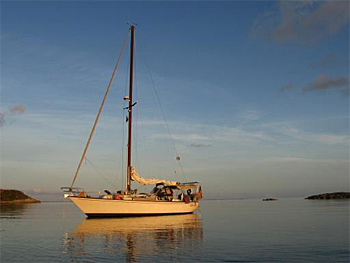 |
|
Sirius II
at anchor, Manzanillo Bay |
As evening
approaches, I choose to go into the industrial port of Manzanillo, a large,
open bay just on the border with Haiti.
I share the port with a banana boat, loading cargo for Belgium.
The next
morning I re-read the manual for the auto pilot, a product of Raymarine, an
American company. I do this; I
do that. By noon I decide that I
have done all I can. I will
leave at sunset, with a course toward Santiago, Cuba (I have given up on
Jamaica) if the auto pilot works; back to Luperon if it does not.
You know
the rest of the story. Well,
maybe not all of it. Within two
hours of steering by hand, I make the turn to go back to Luperon.
It is now dark and I am completely at the mercy of my instruments.
There is no moon. I mean,
it is dark, except for flashes of lightning I see in the distance behind me.
The first
four hours from Manzanillo to Montecristi are pretty treacherous—small
islands, reefs and rocks.
Siete Hermanos. I feel
confident as I have been here before.
Right about in the middle of this course I see a flash of lightning
and then nothing. Scary darkness.
No light from the GPS in the cockpit;
no light from the laptop in the cabin.
No navigational aids. Apparently,
the boat received some of the charge from that lightning.
My first thought (and I kid you not)
is, “What would Christopher Columbus do now?”
Well, of
course he had a crew to whom he could issue orders, so that is out of the
question for me. What I did
do—the compass light is still working and I dutifully note the course I am
on. I know that I have to hold
this course for a least the next 10 – 15 minutes.
I reduce the boat speed.
Then I try to figure out when the moon will rise.
With moonlight I might be able to see some landmarks that I can use
to determine where I am. Maybe.
I lock the
wheel in place and go down into the cabin to see if the computer is still
alive. That way I can at least
see my charts. It is.
As a matter of habit, I touch the restart button on the GPS that
feeds it. Eureka! It comes on!
In a matter of seconds I can see the boat’s location on the chart.
Am I relieved? There is
no way I can express this.
Once I
pass the landmark called El Moro, it is relatively clear sailing.
The trip from Mansanillo to Luperon into the wind is about 12 hours.
I am on the wheel about 11 of these 12 hours.
No coffee break. No pee
break. No sleep.
I arrive
back at the channel to Bahia Luperon shortly after daybreak.
Brian (s/v Chinook) comes over in his dinghy to help me tie up to the mooring
buoy, just as the trade winds are starting to take over the anchorage.
Then, it is a matter of checking back in with the authorities and
explaining to the rest of the cruisers why I am back where I started.
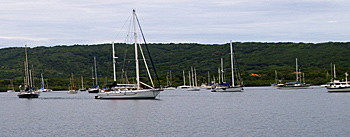 |
| Bahia Luperon, looking to the east, showing the protective hills and boats using this safe anchorage |
After a
couple of phone calls to Raymarine, it is obvious that they can’t help me
long distance. I decide to
terminate this phase of the itinerary, gather the parts to the auto
steering, and take them with me back to Florida.
I secure the Sirius II for
another extended absence.
Patrick from Island Dream, takes
me into the (new) government dock.
He assures me that he and Darnell will keep an eye on my boat for me.
About the
loss of both GPS’s apparently due to lightning:
I am not sure exactly what happened.
I have mentioned that I was able to restart the cabin GPS, but not
the GPS in the cockpit. This one
has an in-line fuse and I assumed that was broken.
Later, when I went to replace it, the fuse was OK!
So, what did happen?
Maybe there is something to the
Bermuda Triangle stories.
Anyway, I re-wired the GPS so that if I need to replace the fuse in the
future, it is more assessable.
So ends
Part I of the 2011 episode of the voyages of the Itinerant Sailor.
![]()
[1] This marks an interesting chapter in my life. Barbara and I were part of a group of 20 some Fulbright Scholars to study at the University of Washington during the summer of 1978, then to travel and study in Egypt for six weeks. Due to this experience, and perhaps due to some inner convictions we already had, we met for the next few months with other Fulbright Scholars
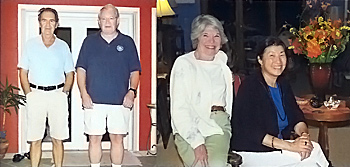 |
| Steve, David, Barbara and Judy, 30 years
later. |
Our efforts culminated in a “Teach Peace”
dinner/workshop attended by dozens of Seattle area teachers.
The key note speaker was Giovanni Costigan, a prominent
University of Washington professor (a “Great Soul,” in the words of
Judy Mukai), whose eloquence and passion for these ideals was an
inspiration for all of us.
[2] As we are
and have been in a global recession for the last few years, I am
often asked about the economy of the Dominican Republic.
As if I should know, one who cannot speak the language and
can just barely read it.
But I can make observations.
As is typical of developing countries everywhere,
and the United States, the chasm between the rich and poor continues
to grow. Having said
this, I note that the economy of the capital, Santo Domingo, is
bustling. Office
buildings, sky rises, apartment buildings are being built, or have
just been completed, throughout the city—even though existing
buildings are adorned with signs that say
se vende for sale or
alquiler for rent.
Why are they building when the market is already glutted?
The explanation we hear is that money sitting in banks draws
little or no interest.
So those with money choose to build even if it might be difficult to
rent or sale. And the
infrastructure cannot support existing customers.
Everyday throughout the Island that are black outs due to
electrical shortages.
Two questions come to mind:
(1)How is it that so many people in the Dominican Republic
have so much cash? And
(2) what will this do to the economy in the long run when prices and
rents drop due to this glut on the market?
This seemingly robust economy is not true of the
rest of the country, except in some of the popular tourist areas
such as Punta Cana, La Romana, etc.
Santiago and Puerto Plata, the next two major cities, have
high unemployment rates and closed businesses, as do most of the
smaller towns, including Luperon.
Sounds like home, eh?
Cruising 2011: The Little Ship that Couldn't
Copyright © 2011 Steven Jones. All Rights Reserved.
Contact: siriusii@hotmail.com